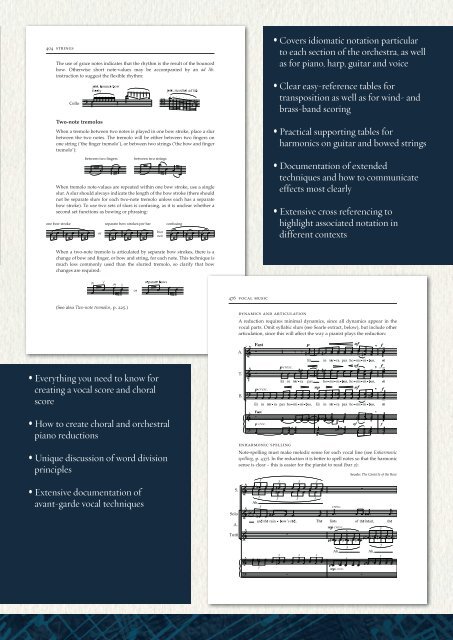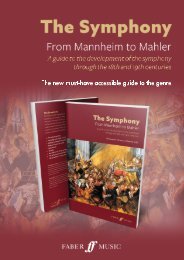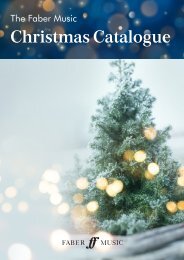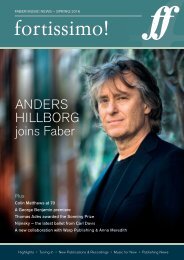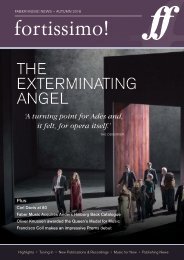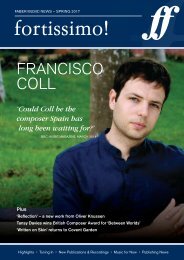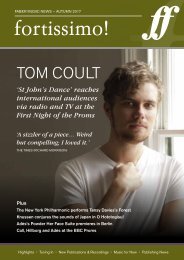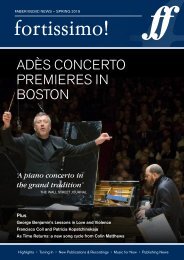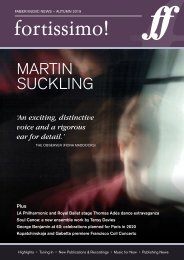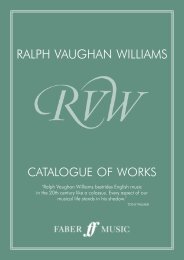Behind Bars the definitive guide to music notation
Specialist music editor Elaine Gould provides a comprehensive grounding in notational principles in this seminal reference work, the most thorough guide ever published in this field. An essential resource for composers, editors, music setters, students and teachers, Behind Bars covers everything from basic rules of mainstream practice to complex instrumental and vocal techniques and new technologies.
Specialist music editor Elaine Gould provides a comprehensive grounding in notational principles in this seminal reference work, the most thorough guide ever published in this field. An essential resource for composers, editors, music setters, students and teachers, Behind Bars covers everything from basic rules of mainstream practice to complex instrumental and vocal techniques and new technologies.
Create successful ePaper yourself
Turn your PDF publications into a flip-book with our unique Google optimized e-Paper software.
404 strings<br />
The use of grace notes indicates that <strong>the</strong> rhythm is <strong>the</strong> result of <strong>the</strong> bounced<br />
bow. O<strong>the</strong>rwise short note-values may be accompanied by an ad lib.<br />
instruction <strong>to</strong> suggest <strong>the</strong> flexible rhythm:<br />
Two-note tremolos<br />
When a tremolo between two notes is played in one bow stroke, place a slur<br />
between <strong>the</strong> two notes. The tremolo will be ei<strong>the</strong>r between two fingers on<br />
one string (‘<strong>the</strong> finger tremolo’), or between two strings (‘<strong>the</strong> bow and finger<br />
tremolo’):<br />
When tremolo note-values are repeated within one bow stroke, use a single<br />
slur. A slur should always indicate <strong>the</strong> length of <strong>the</strong> bow stroke (<strong>the</strong>re should<br />
not be separate slurs for each two-note tremolo unless each has a separate<br />
bow stroke). To use two sets of slurs is confusing, as it is unclear whe<strong>the</strong>r a<br />
second set functions as bowing or phrasing:<br />
• Covers idiomatic <strong>notation</strong> particular<br />
<strong>to</strong> each section of <strong>the</strong> orchestra, as well<br />
as for piano, harp, guitar and voice<br />
• Clear easy-reference tables for<br />
transposition as well as for wind- and<br />
brass-band scoring<br />
• Practical supporting tables for<br />
harmonics on guitar and bowed strings<br />
• Documentation of extended<br />
techniques and how <strong>to</strong> communicate<br />
effects most clearly<br />
• Extensive cross referencing <strong>to</strong><br />
highlight associated <strong>notation</strong> in<br />
different contexts<br />
When a two-note tremolo is articulated by separate bow strokes, <strong>the</strong>re is a<br />
change of bow and finger, or bow and string, for each note. This technique is<br />
much less commonly used than <strong>the</strong> slurred tremolo, so clarify that bow<br />
changes are required:<br />
476 vocal <strong>music</strong><br />
(See also Two-note tremolos, p. 225.)<br />
dynamics and articulation<br />
A reduction requires minimal dynamics, since all dynamics appear in <strong>the</strong><br />
vocal parts. Omit syllabic slurs (see Searle extract, below), but include o<strong>the</strong>r<br />
articulation, since this will affect <strong>the</strong> way a pianist plays <strong>the</strong> reduction:<br />
• Everything you need <strong>to</strong> know for<br />
creating a vocal score and choral<br />
score<br />
• How <strong>to</strong> create choral and orchestral<br />
piano reductions<br />
• Unique discussion of word division<br />
principles<br />
enharmonic spelling<br />
Note-spelling must make melodic sense for each vocal line (see Enharmonic<br />
spelling, p. 437). In <strong>the</strong> reduction it is better <strong>to</strong> spell notes so that <strong>the</strong> harmonic<br />
sense is clear – this is easier for <strong>the</strong> pianist <strong>to</strong> read (bar 2):<br />
• Extensive documentation of<br />
avant-garde vocal techniques


